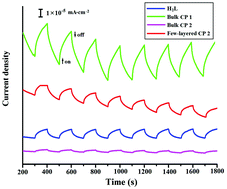Photocurrent-generating properties of bulk and few-layered Cd(ii) coordination polymers based on a rigid dicarboxylate ligand†
Abstract
Based on a rigid ligand, 2,5-bis[3′-carboxyl-phenyl] pyridine (H2L), two coordination polymers (CPs) formulated as Cd3L3(DMF)4 (1) and CdL(DMF)·DMF (2) were solvothermally synthesized and characterized by single-crystal X-ray diffraction. CP 1 is a uninodal 6-connected 3D network with a {44·610·8}-mab topology, in which the Cd3 unit with a Cd⋯Cd separation of 3.61 Å is observed. CP 2 exhibits a uninodal 2D layer with a 44-sql topology, in which Cd(II) ions are linked into a Cd–O–Cd chain with a Cd⋯Cd separation of 3.91 Å. DFT calculations indicate that CP 1 possesses a more narrow band gap than CP 2, and CP 1 yields higher photocurrent density upon visible light illumination than CP 2. In the present work, the few-layered CP 2 has been in situ synthesized, and it shows enhanced photocurrent density with respect to the bulk CP, which is probably associated with the large fraction of uncoordinated surface atoms and dangling bonds in the nanosheet of CP 2.


 Please wait while we load your content...
Please wait while we load your content...